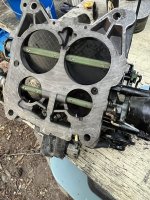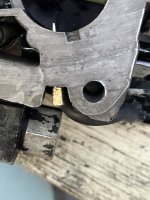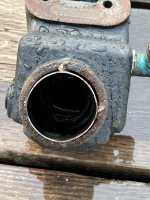My 180 won’t idle. It seems like it’s flooding. Its starts easily if I give it quite a lot of throttle, and sounds fine above 2000 RPM. When I ease the throttle back to 1800 or less, the rpm goes up and down a couple of times, then stalls.
Recent history: The two 180’s are new to my boat, so I don’t have an operating history, but I trust the marine mechanic who was maintaining them in the boat they just came out of and said they were in good running condition. I’ve only had the boat out for three sea trials. The port engine started easily and idle well for all three trials, But had very low power on the first two trials. I replaced the pertronix ignition and it had good power and ran fine initially on trial number three but started overheating so I shut it down and returned on stbd engine.
Since then, it won’t idle, as described above. Seems like it’s flooding at low throttle. I swapped the Rochester Quadrajet carb with the Quadrajet carb off a 488 (very similar but not identical; it was working fine on the 488). That didn’t change anything. Still sounds fine above 2000 rpm, surges and stalls if reduce throttle to 1800 rpm. So I’m thinking the problem isn’t in the carb itself.
All the tests have been at dock, in neutral.
My online reading suggests the (only?) other cause or to be high fuel pressure. But I haven’t touched the fuel pump since the engine was idling fine on the first two sea trials, and at the start of the third. Nevertheless, I guess my next step is to get a fuel pressure gauge.
I don’t think the engine overheated to a critical level on the third sea trial. And I also don’t see how overheating could have lead to the stalling at idle problem.
Help, please!
Recent history: The two 180’s are new to my boat, so I don’t have an operating history, but I trust the marine mechanic who was maintaining them in the boat they just came out of and said they were in good running condition. I’ve only had the boat out for three sea trials. The port engine started easily and idle well for all three trials, But had very low power on the first two trials. I replaced the pertronix ignition and it had good power and ran fine initially on trial number three but started overheating so I shut it down and returned on stbd engine.
Since then, it won’t idle, as described above. Seems like it’s flooding at low throttle. I swapped the Rochester Quadrajet carb with the Quadrajet carb off a 488 (very similar but not identical; it was working fine on the 488). That didn’t change anything. Still sounds fine above 2000 rpm, surges and stalls if reduce throttle to 1800 rpm. So I’m thinking the problem isn’t in the carb itself.
All the tests have been at dock, in neutral.
My online reading suggests the (only?) other cause or to be high fuel pressure. But I haven’t touched the fuel pump since the engine was idling fine on the first two sea trials, and at the start of the third. Nevertheless, I guess my next step is to get a fuel pressure gauge.
I don’t think the engine overheated to a critical level on the third sea trial. And I also don’t see how overheating could have lead to the stalling at idle problem.
Help, please!






















